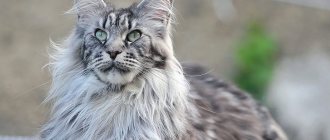Pets of the feline species have been tamed for a long time and live in apartments and houses of people. Breeders are constantly working to create new breeds, but there are species that are undeservedly unpopular. The Cornish Rex belongs to this group, and breeders believe that this is unfair, since it is difficult not to fall in love with them.
Description of the breed
Now there are two currents in Cornish breeding: European and American. The cats of the American version are more elegant, have big ears, look like porcelain figurines, and have thin bones. In the European version, all these signs are not so pronounced; the individuals are closer to the first representatives of the breed, not far from the natural cat appearance.
Pedigree kittens in the first days of life
For your information! Nina gave the new breed a name by analogy with rabbits: “rex” meant “curly”, and “cornish” reflected their origin.
Breed standard
Rex cats should have strong muscles, an elongated and slender body, fairly strong hips, powerful rump and shoulders. The arched curve of the Cornish's back is noticeable even when the cat is just standing.
How long do cats live at home?
The Cornish cat's legs are long and slender, and its paws have five toes in front and four in back. The head is small, oval, with smooth curves, but chiseled cheekbones and a firm chin. The tail is flexible, thin and long.
The most important feature of the breed is its coat. It is soft, short and curls in waves. There are no guard hairs. Curls become especially noticeable on the underside of the chin, on the abdomen and chest.
Possible colors:
- white;
- black;
- blue;
- red;
- cream;
Important! The wool should be colored evenly, without tints, other shades or patterns.
Origin story
The history of these amazing cats began in the mid-20th century in the southwestern part of Great Britain in the county of Cornwall. On the farm of rabbit breeder Nina Ennismore, an ordinary tricolor cat gave birth to a baby with curly, cream-colored fur, who was named Calibanker. He had such an amazing appearance that in the first months of his life his owner tried to treat him for various diseases. The baby differed from his brothers and sisters not only in his strange curly undercoat, but also in his too thin physique and elongated limbs.
After consulting with geneticists, Nina Ennismore decided to conduct an experiment to breed a new breed of curly-haired cats. To begin with, she decided to cross the grown-up Kalibanker with his own mother. As a result, two more babies with wavy hair were born. The new breed was named Cornish Rex. Then mating occurred with other cats. The litters included kittens with both wavy and smooth coats.
In the late 50s, Nina published photographs of extraordinary cats in Life magazine. This led to the fact that the first curly-haired representatives immediately gained enormous popularity among felinologists. The breed began to be bred in both Europe and the USA. This is how two intrabreed types of cats appeared:
- American - distinguished by the following characteristics: graceful physique, long and thin-boned limbs, large ears.
- European - features: stocky build, medium-sized ears.
Both representatives, despite the visible differences, have one unique quality - curly and very soft fur. They are also similar in character.
Character
The Cornish cat is an intelligent, active and playful creature. The beast explores every corner of the apartment and will climb everywhere, especially where the cat’s paw should not go. Thanks to its high intelligence, a kitten can even learn to bring a ball to its owner, but it will only do this when it wants to.
How long do castrated cats live at home: lifespan
Such a pet will happily lie on your lap and spend a lot of time with a person. He is also friendly to other pets.
Cornish is a typical homebody who is unlikely to want to escape into the street through a randomly opened door. They do not like to change their usual environment; after moving to a new apartment, kittens may even meow in bewilderment for several days. This lasts from a week to a month; new owners have nothing to worry about, since this behavior is quite natural.
Note! Corniches are quite talkative, they have a peculiar thin voice. The kitty doesn’t mind using it at any time when she needs something from her owner.
Features of communication
Cornish Rexes are very active and friendly. They are great companions. This breed is ideal for those with small children. Energy, playfulness and peacefulness will surprise anyone. And even when the child is already tired, these wavy fidgets, after resting for a couple of minutes, can continue playing.
If they usually say about cats that “they walk on their own,” then Cornish cats are a pleasant exception. They love communication, games, running around. Cats of this breed are always close to their owner. If desired, they can be taken outside; a leash is needed for this. Experienced breeders recommend accustoming babies to this accessory from the age of four months.
If strangers visit the house, Cornishie will have no problem keeping company and will even sit on his knees to warm up. One can only envy their sociability and socialization.
Reproduction of Cornish Rex
Already at the age of nine months, a cat can have offspring, but it is better to wait until one year. Then the animal will definitely be able to bear healthy cubs. In a year, a female can give birth two or three times, with an average litter of five kittens. Usually childbirth is easy, but the estrus itself is violent, especially in the summer. It is difficult for a breeder to miss this moment.
Persian cat: description of breed and character, how long they live
Before mating, it is necessary to treat the animals for parasites and trim the claws on their paws so that they do not scratch each other. The cat should stay in the cat's house for 3-6 days. When she begins to lightly rub her back on the floor and allows the male to approach her, you can take her back.
If after four weeks there is no new heat, the cat is pregnant. Cornish cats are gentle and caring parents.
Important! Mating with representatives of other breeds is officially prohibited.
Health, tendency to disease
Corinche Rex cats are distinguished by good health; a possible reason for good immunity is a slightly elevated temperature (38.5-39 ° C). No genetic problems (breed diseases) were found. The most common types found in rexes are:
- skin diseases (dermatitis),
- colds and respiratory diseases,
- gastrointestinal disorders,
- cystitis (inflammation of the bladder).
Animals tend to overeat, which can cause obesity. Cornish Rexes are very sensitive to anesthesia drugs, therefore, unlike cats of other breeds, they take longer to recover from anesthesia. An overdose of sedatives used before surgery can cause complications: deafness, neurological disorders, damage to brain cells, and death.
It is recommended to have a first aid kit for your cat. Need to buy:
- cotton wool,
- cotton buds,
- elastic bandage,
- gauze,
- patch,
- brilliant green,
- iodine,
- hydrogen peroxide,
- Activated carbon,
- Vaseline oil (Vaseline),
- scissors with blunt tips,
- tweezers,
- eye dropper,
- rectal thermometer,
- syringes, incl. insulin,
- ammonia,
- boric acid powder,
- streptocide powder.
Vaccination
They begin when the kitten is 8 weeks old. First you need to rid the animal of fleas and ticks, then deworm it. The remedy for parasites is given 10-12 days in advance. before vaccination. First, they are vaccinated against panleukopenia, calicivirus and rhinotracheitis. Revaccination is necessary after 2-4 weeks, then 1 time per year.
Starting from the age of 12 weeks, they are given a rabies vaccination (once), revaccination – annually.
After 2-3 weeks. The kitten is vaccinated against fungal diseases. 2 injections are required, with an interval of 10-14 days, revaccination - every year.
Quarantine after vaccinations should last 10 days, during which it is important to protect the baby from:
- overheating,
- hypothermia,
- strong physical activity,
- long transportations,
- contact with other pets,
- suspected sources of infection (for example, street shoes).
Castration and sterilization
If you do not plan to breed offspring, you can spay or neuter your pet.
Good reasons for castration:
- the cat will not mark;
- the pet’s life will be a couple of years longer, since the operation will relieve it of testicular cancer or prostatitis;
- the animal will not run away to join the horde of stray kittens, nor will it get caught in the mouth of a dog or run over by a car.
This bandage will protect the stitches from the cat's tongue.
Reasons for sterilization:
- the cat will not catch diseases caused by excess sex hormones;
- There is no such thing as mating “for health”. Frequent pregnancies, which wear out the mother’s body, are especially harmful;
- You won’t have to listen to the heart-rending meowing of your pets.
Important! Medications to suppress sexual activity are not the solution. They do not save you from diseases; on the contrary, they can provoke their development.
The operation is simple and safe: for males it will take about five minutes, for females - 10-20 minutes. Recovery is also quick, cats have stitches removed after 10-12 days, cats don’t have them applied at all
Breeders' recommendations
Cornishes, like other kittens, are taken from the nursery no earlier than 3 months of age. At this age, they no longer depend on their mother, eat any type of food on their own and easily navigate the apartment, finding a kitchen, a toilet with a tray, their own bed and a place to play. The three-month-old kitten is sufficiently socialized and familiar with the rules of the hostel, as he lived for a long time with his mother and his brothers and sisters. That is why he is more tolerant and calm than a kitten who was separated from the cat too early and moved to a new family.
Attention. Due to the compactness of the breed, a Cornish Rex kitten at 3 months seems very small (which does not indicate underdevelopment), even if you saw it in photographs and there it looked large.
There is a persistent misconception that a 3-month-old kitten is not able to become as attached to a new family as a one-month-old kitten. In reality, everything depends on the care shown by the person - six-month-old and one-year-old Cornish Rex selflessly love their owners, even when they come to them as adults. In addition, not a single good breeder will sell animals without routine deworming and immunization, which are prescribed no earlier than 3 months.
Return to content
Care
The same recommendations are relevant for owners of Cornish cats as for owners of other cats. Firstly, the animal needs a separate sleeping place. A box with a soft towel inside or something from a wide range of pet stores will do. It should be placed in a quiet, warm corner of the house, where the pet will feel safe.
One of the bed options
Secondly, it is advisable to purchase food bowls that will not slide on the floor, as this is inconvenient.
Note! You can get a scratching post to protect upholstered furniture from cat paws. To arouse your pet's interest in it, you can lightly soak it in valerian or rub it with catnip.
Of course, the main question about care that arises among potential Cornish owners is about wool. It is recommended to comb it with a brush with bristles made from natural materials a couple of times a week. It is better to avoid iron teeth so as not to frighten the cat with static electricity.
Since the coat is quite short, it gets dirty from the secretions of the sebaceous glands. The cat is washed every few months. When bathing, you need to make sure that water does not get into the animal’s nose, eyes and ears - there is no need to add unpleasant sensations to it and create negative associations with the bath. Sometimes you can replace regular shampoo with waterless one.
Rex sheds, but this is practically not noticeable in everyday life, because the hairs are quite thin.
Important! You cannot dry Cornish cats with a hairdryer. It’s better to blot it with a towel and then play, so that the heat dries the fur faster.
It is worth removing discharge from your cat's eyes daily with a cloth or cotton pad soaked in water. Every week you need to clean your ears with a cotton swab and Vaseline. You only need to remove wax from the visible part of the ear.
It is not necessary to trim your cat's claws. But you can buy nail clippers and cut off the transparent part of the claw by a couple of millimeters so that the pet does not cling to furniture and cannot scratch the owner.
To prevent unpleasant odor from the mouth and the formation of tartar, it is worth purchasing toothpaste and a brush for cats at the pet store every month. With their help, you can easily clean your pet's fangs.
| pros | Minuses |
| Friendly, playful, sociable | Stubbornness and willfulness |
| Interesting appearance | Obsessiveness |
| Easy to care for | Possible health problems, especially with digestion |
These breeds are confused due to their similar curly coats and possibly origins: both were developed in southwest Britain. This is where the similarities end and the differences begin: What is the difference between the Cornish Rex and the Devon Rex
- head shape. The Cornish have an egg-shaped head, while the Devon has a heart-shaped head;
- ears. In the Devons they are clearly larger;
- body type. The graceful cats from Cornwall are not at all like the tightly built little athletes from Devonshire;
- wool. So similar at first glance, it is actually very different. The tips of the Devon's hairs point upward, creating a feeling of tousle, while those of the Cornish look downward.
SIGNS OF APPROACHING BIRTH
Throughout pregnancy, the cat arrives in a calm state, sleeps a lot and eats well. The cat's belly does not allow her to be active and jumping as before.
On the day of birth, your pet's behavior changes radically, so you will immediately understand that this day has come. The cat becomes restless, endlessly walks around the apartment or after the owner, refuses to eat and may scream unnaturally. These are signs of childbirth in a cat. More precisely, the first stage of labor is contractions, which can last up to 12 hours and are accompanied by bloody discharge from the vagina.
Complications in the process are also possible. For example, if your cat cannot give birth to her first kitten 6-7 hours after her water breaks, or if the kitten is stuck in the birth canal (and this unfortunately happens), call the veterinarian, because The cat needs help. An unresolved placenta is also a serious cause for concern, because... this is the cause of possible subsequent inflammatory processes in the cat.
British cats, like Scottish cats, should give birth for no more than 24 hours in total from the moment contractions begin. But most often they pass faster - 5-7 hours, depending on the number of kittens.
During this period, it is best to be nearby, stroke your pet, massage her tummy.
The second stage is the actual appearance of the kittens. The kitten should come out of the birth canal with its head (but it often happens the other way around). It appears in the amniotic sac, which the cat must bite through and gnaw through the umbilical cord. Sometimes the cat does not have time to do this if the next kitten is already on the way. This happens very often, because... the interval between the appearance of kittens can be only 5 minutes. At such a moment, the cat is not able to release and lick the already born one. This is where your help will be needed. Free the baby from the bladder yourself and carefully wipe it; if the umbilical cord is long, then cut it with scissors, leaving a length of 1.5-2 cm from the kitten’s abdomen. Treat the edge of the umbilical cord with any antiseptic. Examine the kitten, listen to its breathing, it should be uniform. If this is not the case, then the kitten has inhaled amniotic fluid and it has entered the lungs. Gently tilt it head down and hold it until it beeps. Check the kitten's tongue, it should be pink, which means normal breathing and sufficient oxygen in the body.
During the birth process, put the kittens in one specific place yourself. When it's all over, present your cat with a box of kittens, the box should be spacious so that she can lie next to them and feed them.
A cat's behavior after giving birth can sometimes be completely unpredictable. It happens that at first the cat refuses to feed the babies or does not approach them at all. There is nothing wrong with this, it’s just that the “new mother” has not yet gotten used to them and has not realized her role. You just need to help her a little: place the kittens next to her with their muzzles to the nipples. It’s better not all at once, but gradually, one at a time. The kittens have her scent and she will start licking them anyway and “recognizes” them. If the kittens start eating, then everything is fine. Praise your pet, even better, sit next to her while she feeds, stroke, caress her. Bring her her favorite food and milk or sour cream directly to the rookery. After all, a cat after giving birth for the first time can lie next to the kittens for almost a day without even leaving to go to the toilet or to the bowl. And after such a big undertaking, you need to gain strength. In general, further nutrition should be enhanced and contain more dairy and fermented milk products.
How to choose a kitten
Cornish dogs were very popular in the middle of the last century, but now interest in them has subsided a little. But you can still find a good Cornish Rex nursery. For example, "Gioconda", a Moscow nursery registered with the World Felinological Association.
Corish Rex kittens are charming, captivating from the first minutes
Here are some tips on how to choose a fur baby:
- you need to look at your parents. The behavior and appearance of the offspring are likely to be similar. You should refuse to buy if you don’t like some character traits or aren’t happy with some exterior details. Particular attention should be paid to what show animals are disqualified for if you want to take part in competitions;
- those who want to buy a kitten for exhibitions or breeding may need the help of a professional who will accurately check that it meets the standards of the Cornish cat breed;
- The seller must have documents for the kitten: birth certificate and veterinary passport. You need to check them before purchasing.
It is not worth buying kittens secondhand, as there is a risk of purchasing an animal that does not meet the breed standards, or an animal with health problems, which will then have to be treated.
In general, Cornish dogs are friendly pets, not very demanding in care, and capable of becoming real family members.
Feeding the cat
Many experts recommend giving Cornish Rex dogs premium or super premium drying. When choosing food for curly-haired cats, it is advisable to pay attention to its composition and expiration dates.
It is important to remember that the main characteristic of any high-quality drying is the absence of wheat, corn, soy, dyes and preservatives.
Cornish Rex eat the following brands of food with appetite:
- Hills;
- Grandorf;
- Pronature;
- Monge.
If the diet of curly-haired cats consists of natural products, then lean varieties of meat should predominate in it. Cornish Rex cats are also given ocean fish, vegetables, cereals, sour milk and quail eggs.
To maintain the health of a purebred pet, fatty meat, river fish, fresh milk, sweets, baked goods, sausages, smoked meats, pickles and any leftovers from the master’s table are excluded from its menu.
Cornish Rex cats are highly active and have an excellent appetite. They are constantly hungry, and if you overfeed them, they will quickly gain excess weight. And a fat pet runs the risk of acquiring a whole “bouquet” of diseases over time.











